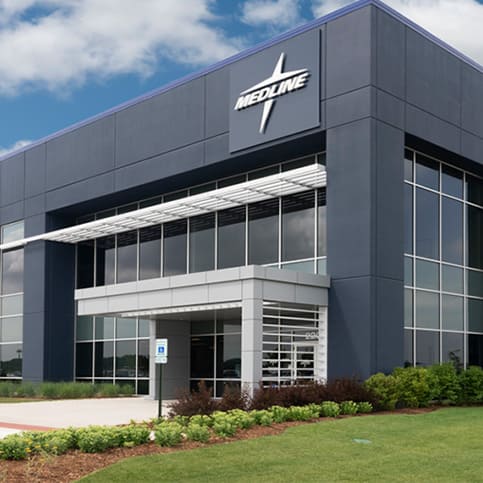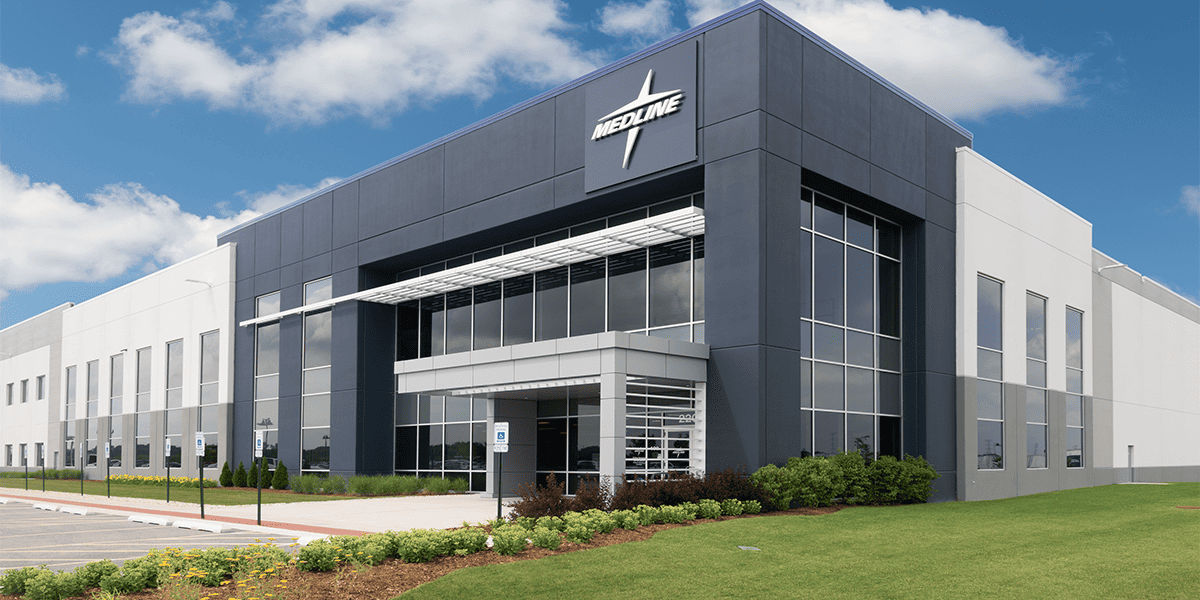With ESG (Environmental, Social, Governance) factors becoming critical to development, environmental sustainability is an important consideration in building design. Our work in the industrial sector plays a key role in transitioning toward a more sustainable future. Below are seven inventive, yet feasible strategies that can be implemented within industrial buildings. The result? Minimization of carbon footprints, a healthier world, and marketable features to appeal to tenants and buyers.
Strategy 1: Target Sustainability In Your Structure And Envelope Design
The initial sustainable strategies should focus on the building envelope and structure. Incorporating lower embodied carbon options into design elements for industrial buildings can be achieved through various approaches.
Embodied carbon is the total emissions from the sourcing, manufacturing, transportation, and installation of materials. For reduced embodied carbon, some common low or no-cost options include:
- Specify low-embodied carbon concrete mix for slabs, foundations,
and enclosure panels. - Investigate slab alternative options like fiber reinforced or Ductilcrete.
- Consider precast alternatives like Nexii
- Specify steel to come from facilities with electric arc furnace (EAF) processes.
You can also consider wood structural alternatives which look beautiful and contribute to a more pleasant working environment but can be cost prohibitive for the scale of industrial buildings.
Operational carbon is the carbon emitted during the operational or in-use phase of a building. To ensure energy efficiency, it is essential to establish a minimum compliance energy performance target and use products that improve the efficiency of the building. Some options include:
- Using high R-value insulated overhead doors to minimize heat loss.
- Opt for high-performance glass or smart windows.
- Incorporate skylights to reduce the need for interior lighting and, as a bonus, positively impact the facility’s workforce.

Strategy 2: Double Down On EV Charging
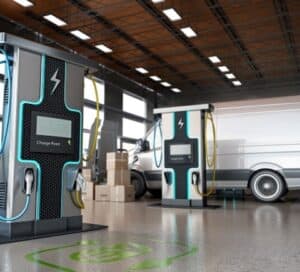
In the context of carbon reduction strategies, EV charging plays a significant role. When it comes to EV cars, many jurisdictions now mandate certain accommodations.
For instance, CalGreen requirements stipulate a range of approximately 20% EV capable and around 25% (EV capable) with chargers installed. The rise of electric fleet vehicles, including semis, will make facilities with appropriate EV infrastructure more attractive to potential tenants. Being prepared for EV charging today is crucial to avoid incurring substantial future costs.
Strategy 3: Optimize Onsite Energy
Reducing the carbon from ongoing operations is another important goal. Onsite energy generation can go a long way to supporting the power needs of the building and surrounding community. Industrial buildings have plenty of roof area to use for photovoltaics (PV). The inclusion of PV systems offers advantages:
- Revenue generation through contracts with solar providers and potentially give back to the
local grid. - PVs can offset the energy needs of the building, which becomes increasingly crucial as the demand for electric vehicle (EV) charging rises.
In many jurisdictions, a PV Ready roof is now a minimum requirement. In addition to roof PVs, there are options for Building Integrated Photovoltaics (BIPV) with multiple design options. Although industrial buildings are wider than they are tall, it is important to consider the size of the façade and the PV opportunities available. BIPVs wouldn’t be a replacement for the entire envelope but including them for specific locations can add design flair along with more onsite energy. Depending on the jurisdiction, costs can be offset by government incentives. Considering the location and feasibility, small rooftop wind turbine systems could also be a viable option.
Strategy 4: Conserve And Manage Water
Cities are increasingly recognizing the importance of decentralized green infrastructure for effective stormwater management. One example is the state of New Jersey, which has implemented new rules statewide to enforce this approach. Embracing the decentralized model not only meets regulatory requirements but also presents an opportunity to transform stormwater management areas into site amenities with attractive landscaping.
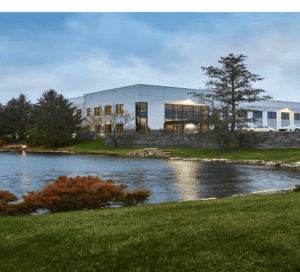
To reduce water consumption, incorporating xeriscaping or implementing a drip irrigation system is recommended. Onsite rainwater capture, where allowed, can be utilized, either for landscape watering or be treated for internal use.
Although the impact on many industrial buildings may be relatively small, it is always wise to install low-flow fixtures with a WaterSense label, further promoting water conservation efforts. For areas experiencing severe water stress, onsite wastewater treatment options should be considered.
Strategy 5: Incorporate Sustainable Materials
Completing a sustainable industrial building means more than just the structure and envelope. You must consider the interior materials, too. A speculative industrial building will have limited office space that is frequently expanded with tenant occupancy. Build-to-suit industrial can have extensive offices rivaling typical corporate office spaces. Making environmentally friendly material choices is possible with limited to no additional cost and should be considered for every project.
This doesn’t have to be complicated. By focusing on the larger quantity items such as insulation, drywall, carpet and ceiling tiles you can achieve an overall lower embodied carbon installation.
We recommend using construction materials with transparency data available. Examples of helpful data include:
- Environmental Product Declarations (EPD)
- Health Product Declaration (HPD)
- Recycled content %
- FSC Certified wood products
The design team can use this data for strategic decisions and the contractor can be required to submit the back-up information during construction to confirm the products being used.
Strategy 6: Feature Health & Wellness Amenities
To effectively market your building for tenant occupancy or to attract and retain employees, it is crucial to incorporate health and wellness options. When you include the necessary infrastructure, even if it means simply allocating space for future use, you can better position your building as a desirable choice.
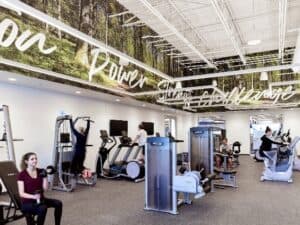
Examples of this include:
- Outdoor gathering areas
- Walking paths
- Dog runs for trucker’s pets
- Exercise facilities with shower spaces
- Enhanced drinking water quality & access
- Healthy interior finish material choices
- Dedicated eating spaces with quality food options
- Restorative spaces (i.e., mother’s rooms, wellness rooms, prayer rooms)
Strategy 7: Prioritize Sustainability Before, During, And After Construction
While many of the strategies above focus on the design phases, it is important to continue the sustainable focus when shifting to the construction phase. Deploy a waste diversion plan to prioritize reuse or recycling of materials rather than sending to a landfill. This will not only minimize environmental impact but also save on embodied carbon by reducing the need for new material extraction and production.
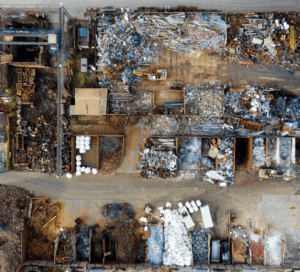
Request use of electric construction vehicles rather than those with combustion engines. This reduces carbon emissions and contributes to a healthier work environment for the construction team. When the project is complete, commission the building systems and envelope to confirm optimum function and support the facility’s energy efficient design features.
Ready, Set, Sustain
Incorporating sustainability practices into building design is essential for creating a greener, healthier world. But remember, it is also crucial to have effective systems in place to track and measure progress. Here’s how you can get started:
- Bring together a team with the experience and enthusiasm to reach your
sustainable design goals. - Start the project by establishing the specific green project targets with the
entire team contributing. - Use benchmarking and metrics to evaluate progress during design and construction, such as:
- Developing an embodied carbon estimate during the early design phases.
- Require a Construction Carbon Plan during construction.
- Develop a Whole Building Life Cycle Assessment (WBLCA).
- Consider targeting a green building certification like LEED, WELL, Fitwel or Green Globes.
While taking these actions can further enhance sustainability efforts, it is important to keep in mind that implementing these strategies should be done with the genuine intent to improve building design and reduce environmental impact, rather than simply checking off a box.
By prioritizing sustainable practices, we can ensure that our buildings contribute positively to the well-being of people and the planet.
At Ware Malcomb, we partner with our team members, clients, industry colleagues and local communities to create a more sustainable world. We strive to develop environmentally friendly business practices to create a healthier built environment for future generations.
